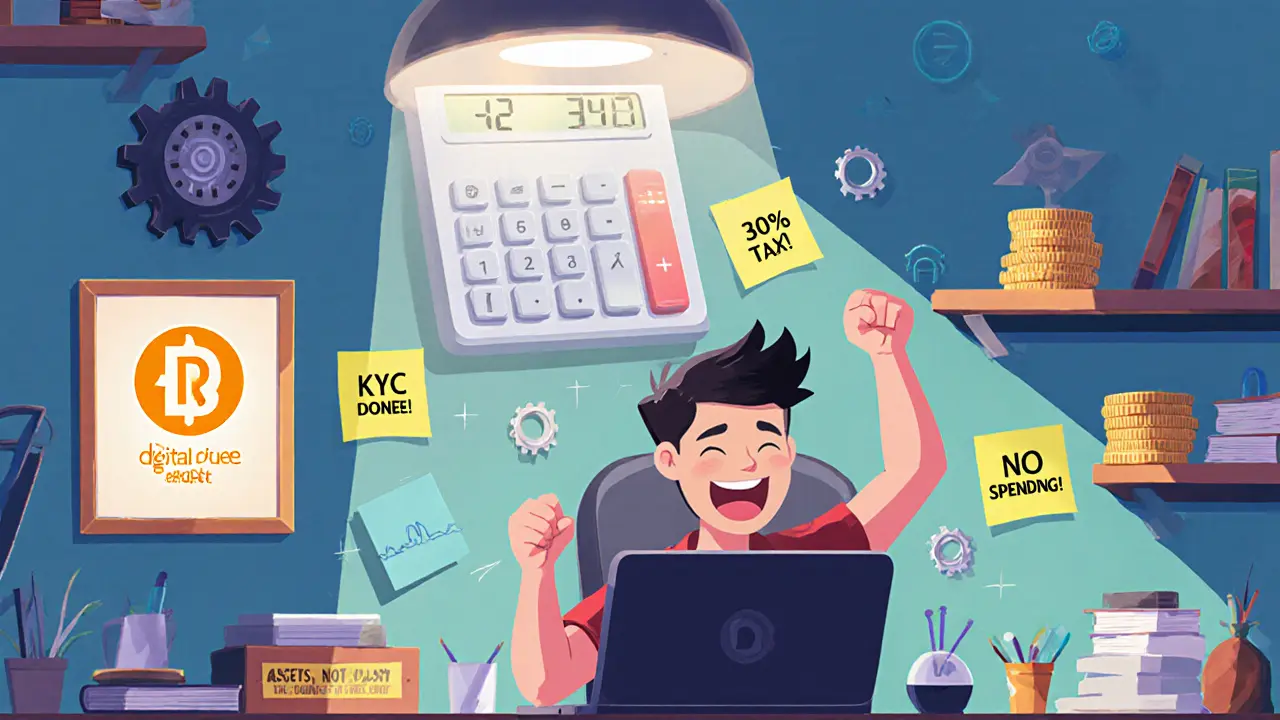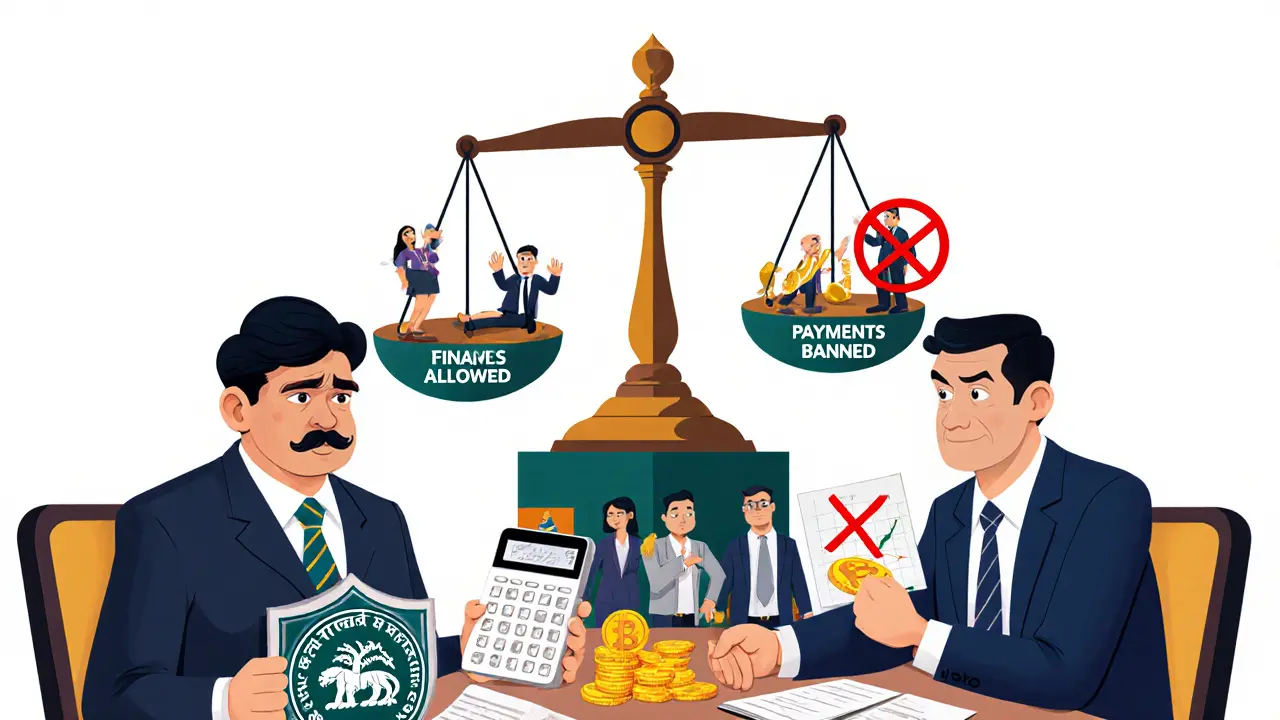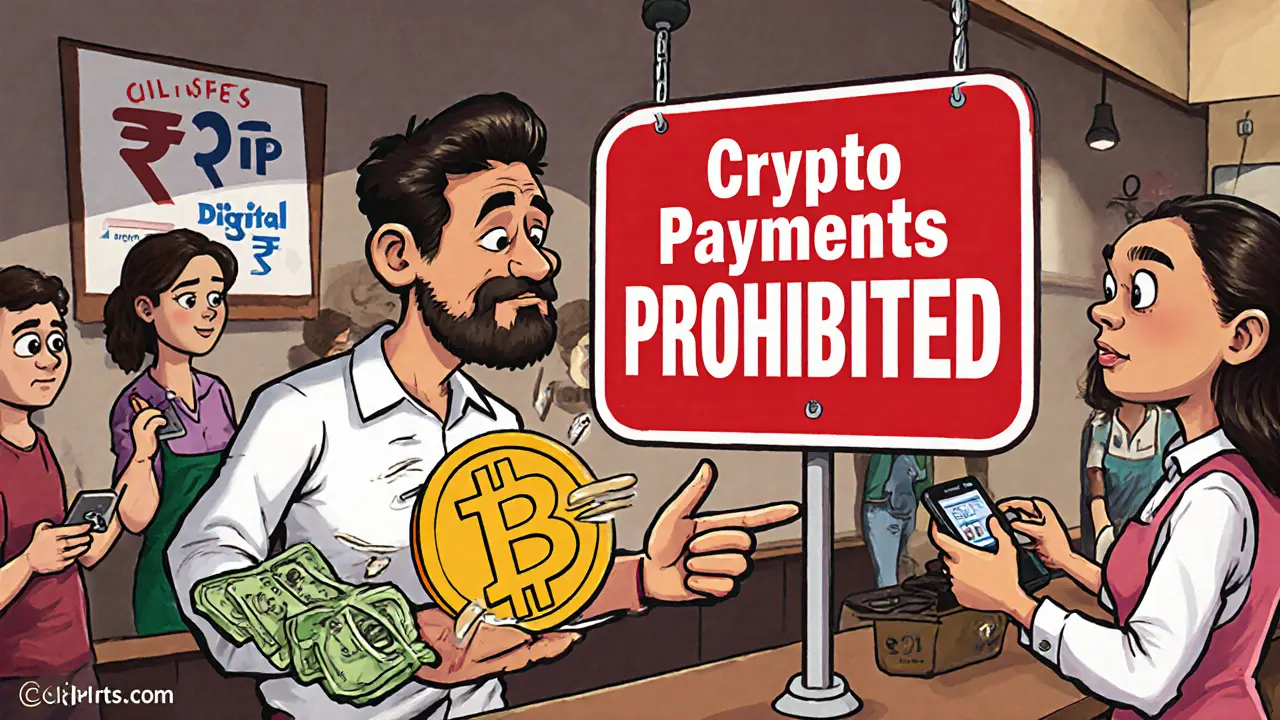Crypto Tax Calculator
Important Legal Note
Warning: This tool calculates taxes on trading activities only. Using crypto for payments (e.g., buying coffee, groceries) is illegal in India as of 2025. The RBI does not recognize crypto as payment instruments.
Tax Breakdown
Profit:
30% Tax on Profit:
1% TDS (Above ₹50,000):
Total Tax Due:
Platform Fees GST (18%):
Note: Platform fees vary by exchange
Can you pay for your coffee with Bitcoin in India? What about using Ethereum to buy groceries? The short answer: no. As of 2025, using cryptocurrencies like Bitcoin, Ethereum, or Solana to pay for goods and services is explicitly banned in India. But here’s the twist-you can still buy, sell, and hold them. The government didn’t outlaw crypto. It just cut off its use as money.
What’s Actually Illegal About Crypto Payments?
The law doesn’t say you can’t own crypto. It says you can’t use it like cash. Under the current framework, any transaction where crypto is exchanged for real-world goods or services-whether at a store, online retailer, or peer-to-peer-is prohibited. This includes paying for Netflix subscriptions, buying NFTs with crypto, or tipping content creators in Bitcoin. The Financial Intelligence Unit of India (FIU-IND) enforces this rule under the Prevention of Money Laundering Act. Platforms that allow crypto-to-goods transactions face heavy fines. In 2024, a local exchange was shut down for letting users pay for mobile recharges with USDT. The penalty? ₹2.3 crore in fines and mandatory KYC overhaul. Even if you find a merchant willing to accept crypto, the transaction isn’t legally protected. If something goes wrong-like a scam or delivery failure-you have no recourse under consumer protection laws. The RBI doesn’t recognize crypto as a payment instrument, so banks won’t help you reverse a transaction.What You CAN Do With Crypto in India
While you can’t spend it, you can trade it. Buying Bitcoin on WazirX, selling Ethereum on CoinDCX, or holding Solana in a wallet are all legal. India’s crypto market is one of the largest in the world, with over 15 million active traders as of late 2025. But there are rules:- You must use FIU-IND registered exchanges (Binance, Bybit, CoinSwitch Kuber, etc.)
- You must complete full KYC-no anonymous wallets allowed
- You must report all crypto gains in your income tax return
Why Does India Ban Crypto Payments But Allow Trading?
This isn’t a contradiction-it’s a strategy. The government wants to control money flows, not kill innovation. By allowing trading, they keep crypto activity visible. Every transaction leaves a digital trail, making it easier to track tax evasion and money laundering. Banning payments protects the rupee. If everyone started paying for groceries in Bitcoin, it could weaken demand for the Indian currency, destabilize inflation control, and undermine the RBI’s ability to manage interest rates. That’s why the central bank pushes hard for its own digital currency: the Digital Rupee (e₹). The Digital Rupee isn’t crypto. It’s a central bank digital currency (CBDC), backed by the RBI, and designed to work like electronic cash. It’s faster than UPI, works offline, and doesn’t need a bank account. Pilot programs are already live in 10 major cities, and by 2026, it’s expected to replace cash for small retail transactions.
Who’s Watching? The Regulators and Their Conflicting Views
India’s crypto rules aren’t written by one agency. Three major bodies are involved-and they don’t always agree.- Reserve Bank of India (RBI): Still hostile. Calls crypto a threat to financial stability. Pushes the Digital Rupee as the only acceptable digital money.
- Ministry of Finance: The tax authority. Doesn’t care if crypto is risky-it just wants its 30%. Also drafted a bill to ban private crypto entirely, but it’s been stuck in Parliament since 2023.
- SEBI: The stock market regulator. Thinks crypto should be treated like a security. Wants to bring exchanges under its oversight, not the Finance Ministry’s.
What Happens If You Try to Pay With Crypto Anyway?
Some people still try. You’ll find Telegram groups offering to pay for Amazon vouchers in USDT. Or local sellers on OLX accepting Dogecoin for laptops. Here’s what happens when you do:- If you’re the buyer: No protection. If the seller disappears, you’re out of luck. Banks won’t reverse the payment.
- If you’re the seller: You’re breaking the law. FIU-IND can trace your wallet. You could face penalties, asset freezes, or even prosecution under PMLA.
- If you’re a platform: You’re a target. In 2024, a startup that let users pay rent in crypto was raided. Their servers were seized. Founders were summoned for questioning.

How Traders Are Adapting
Most Indian crypto users have learned to live with the rules. They treat crypto like stocks, not cash. They track every buy and sell. They file Schedule VDA in their ITR forms. They pay the 30% tax-even when it feels unfair. Some use peer-to-peer (P2P) platforms like Paxful or LocalBitcoins to buy crypto with UPI. Others use international exchanges with Indian KYC. A few even use crypto as collateral for loans-though that’s a gray area too. But everyone agrees on one thing: crypto isn’t money here. It’s an asset. And like gold or shares, it’s something you hold, not spend.What’s Next? The Road to 2026
The government isn’t done. The draft bill to ban private cryptocurrencies is still active. If passed, it could force exchanges to shut down or convert into CBDC service providers. The Digital Rupee is expanding fast. By 2026, it may be used for government salaries, utility bills, and even small business payments. That’s the real future: a state-controlled digital currency, not decentralized crypto. For now, India’s crypto scene is a paradox: the most active market in the world, operating under one of the strictest regulatory regimes. You can trade. You can’t pay. You can own. You can’t spend. And you definitely can’t ignore the taxman.If you’re thinking of getting into crypto in India, remember: this isn’t about getting rich quick. It’s about understanding the rules-and playing within them.
